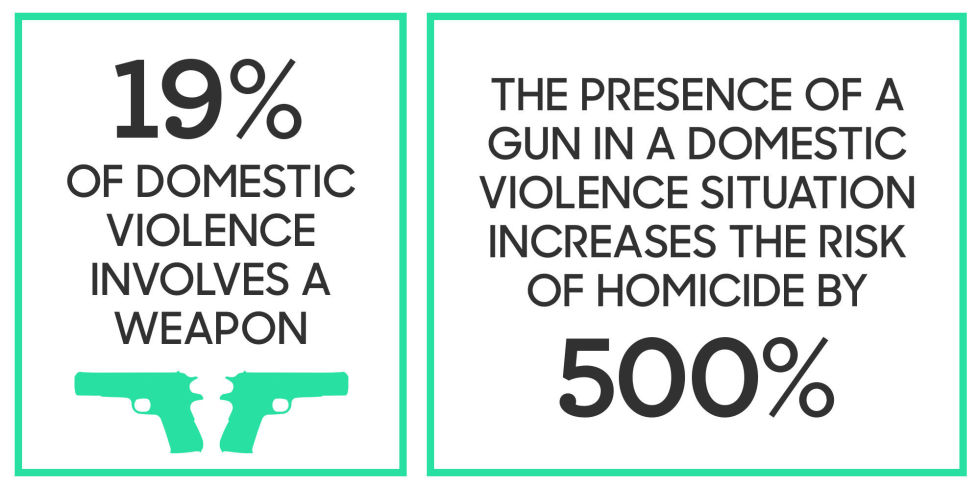The Risk of Weapons in Domestic Violence Scenarios
On average, more than 10 million people in the United States experience some form of intimate partner violence (IPV) each year.1 IPV, also commonly referred to as domestic violence, is defined as the physical, sexual, or psychological abuse perpetrated by a current or former intimate partner or spouse. This term can also encompass the stalking and harassment of a victim by their intimate partner.
IPV disproportionately affects women. Statistics from the Centers for Disease Control and Prevention (CDC) show that 1 in 4 women experience domestic abuse, while typically 1 in 10 men are affected.2
Domestic violence can have a negative impact on others in the household as well; around 1 in 15 children are exposed to IPV each year. 1 Even if a child never was maltreated themselves, children who have been exposed to the abuse of a parent or sibling may be left with enduring trauma.
How Weapons are Used in Domestic Violence Disputes
Overall, around 19% of IPV cases involve some type of weapon. Within a domestic violence dispute, weapons—especially firearms—are typically used to invoke fear and intimidation. Perpetrators may also use weapons as punishment or to coerce the victim into taking whatever action they desire. While the threat of other weapons or bodily force can be catastrophic for the victim, the use of a firearm within a domestic violence dispute is 12 times more likely to cause the death of a victim.3
Put plainly, an abuser’s access to firearms greatly increases the risk of homicide. On average, around 1 in 5 homicide victims die at the hands of an intimate partner. United States crime data shows that at least half of female homicides are caused by male perpetrators of IPV.2

Source: CSR Universal Library
The Push for Firearm Regulation
In recent years, there has been a push for stricter gun laws in the United States. In domestic violence situations, legislation that would regulate who is legally allowed to purchase a firearm could have a massive impact on the survival rate of victims.
Domestic violence organizations and other gun safety advocates have been urging legislators to restrict firearm access for those involved in an ongoing abuse investigation or who have been convicted of domestic abuse.4 This is to mitigate, or perhaps even eliminate, the hundreds of women shot killed by an intimate partner in the United States every year. At this time, 28 states “have enacted laws that facilitate the removal of firearms and/or ammunition by people when they become subject to domestic violence-related protective orders.”3
The most effective and simple proposition for regulating the purchase of firearms is a background check. While some states do require a background check, there is no federal law regulating the requirement of one for all types of sales (eg, a private seller); therefore, abusers tend to purchase firearms privately and independently.
In states with mandatory background checks that bar individuals with a history of domestic abuse from purchasing a firearm, there has been a 13% decrease in intimate partner homicides – a number that could increase if a nation-wide background check mandate is enacted.3
References
- https://ncadv.org/STATISTICS
- https://www.cdc.gov/violenceprevention/intimatepartnerviolence/index.html
- https://giffords.org/lawcenter/gun-laws/policy-areas/who-can-have-a-gun/domestic-violence-firearms/
- https://everytownresearch.org/report/guns-and-violence-against-women-americas-uniquely-lethal-intimate-partner-violence-problem/
Domestic Violence Resources
STM Learning, Inc. has a number of educational resources that focus on domestic violence (eg, Violence Against Women, Domestic Violence and Nonfatal Strangulation Assessment) that are aimed at the prevention and recognition of IPV.
If you or someone you know is a victim of IPV, please visit The National Domestic Violence Hotline for assistance. Bankrate has created a comprehensive resource guide to help survivors regain their independence after leaving abusive relationship, and Wristband has compiled a thorough list of information on the subject as well.
This blog was written by STM Learning’s editorial staff for educational purposes only. It is not intended to give specific medical or legal advice. For expert information on the discussed subjects, please refer to STM Learning’s publications.







